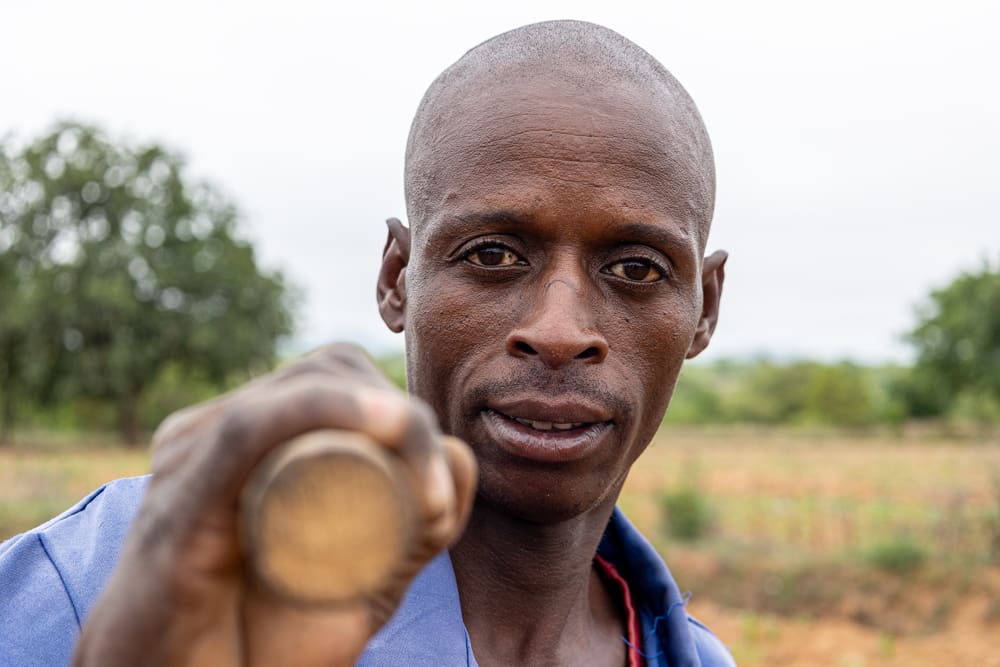Tinashe Pedzai – A Game Changer for Food Security in Zimbabwe
TINASHE PEDZAI, a 37-year-old farmer from Ward 14 of Zaka district Cluster 4 under Chief Nhema, and his wife PRIVILEGE JANGA, were grappling with the deteriorating soil fertility at their household. Their crop yields were declining year after year due to a series of droughts. The future looked grim as the cost of fertilizers soared due to the economic hardships induced by COVID-19.
Written By: GODFREY MUVHUTI and FORTUNE TAFIRENYIKA
However, their circumstances began to change when their household was chosen for a pilot resilience design training in October 2021. During this training, they learned water harvesting techniques and this opportunity led to their participation in multiple Takunda interventions aimed at increasing household resilience through the intentional layering, sequencing, and integration of interventions at the household level.
At his residence, during the ‘walk-the-water’ session Tinashe’s and other participants noticed visible signs of challenges affecting their productivity. Water flow marks were evident, cutting through the field and compound into the home garden. These issues made their site an ideal candidate for resilience designs, as the structures built would be effective in harvesting flowing water and converting problems like soil erosion into opportunities.
Despite these challenges, Tinashe’s eagerness and passion to learn and implement new techniques were key to their success. The poor soil conditions and heavy water flows in their fields had previously prevented them from harvesting meaningful yields for many years. This made it difficult for them to produce substantial yields without using fertilizers – both organic and inorganic compounds – which were becoming increasingly unaffordable. However, with the implementation of Resilience Designs, they were hopeful for a more productive future.
The Pedzai household implemented the following Resilience Design concepts to address their ongoing issues with soil and water conservation, creation of double-dug beds in the Permagarden, dead-level contours averaging 60 meters, interlocking planting basins in the field, and half-moons around trees and water sources and rock check dams to slow the water. These structures were designed to slow, spread, sink, and save water for field use.
When these smart technologies were applied by a passionate farmer like Tinashe, success was bound to follow. Techniques such as mulching, intercropping, and land management were implemented in two Resilience Design plots. combined, these techniques improved soil fertility and enhanced moisture retention, leading to a 45% increase in the his yields in the first season, despite a prolonged dry spell.
Tinashe successfully planted and grew 27 different species of vegetables, fruit trees, and other field crops. He harvested 18 bags of maize (0.9 metric tons) from the two Resilience Design plots (0.25 hectares), a significant increase compared to the 10 bags (0.5 metric tons) harvested in previous seasons using conventional farming methods on the same plot.
Tinashe’s remarkable success with his crops sparked curiosity among passersby and neighbors. Seizing this opportunity, he explained the technologies he used, which led to invitations to train others on these concepts. He went on to train 15 farmers from Ward 13, a non-Takunda Ward, among others from his own ward.
In appreciation of Tinashe’s services, these farmers gifted him grains (approximately 20kg of pearl millet, sorghum, cowpeas, and Pepion peas). He planted these grains on top of the water harvesting structures to enhance biodiversity and conserve harvested water.
The implementation of these concepts significantly improved crop production at the household level by enhancing moisture retention and increasing food variety. The resilience design and Permagardens practices resulted in living soils, fertile soils, healthy plants, and increased water percolation and retention. This ultimately led to an enhanced biodiversity and a health-resilient ecosystem at the Pedzai household. Consequently, Tinashe saw improved crop yields in both his fields and permagarden.
Following this success, Tinashe was invited to showcase his knowledge at the CARE International in Zimbabwe stand during the Zimbabwe Agricultural Show, a national platform at held in September 2023. His engagements at the event led to securing consultancies where he will spearhead the uptake of resilience design for a fee.

